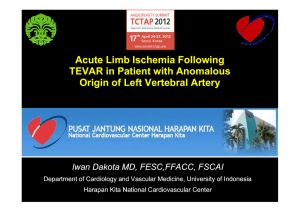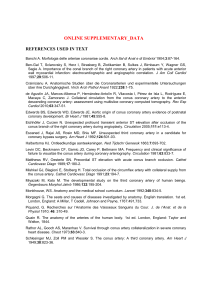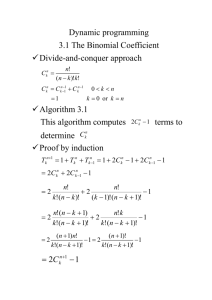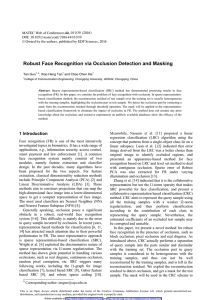ECG CHRONOLOGIC EVOLUTION 72-year
advertisement
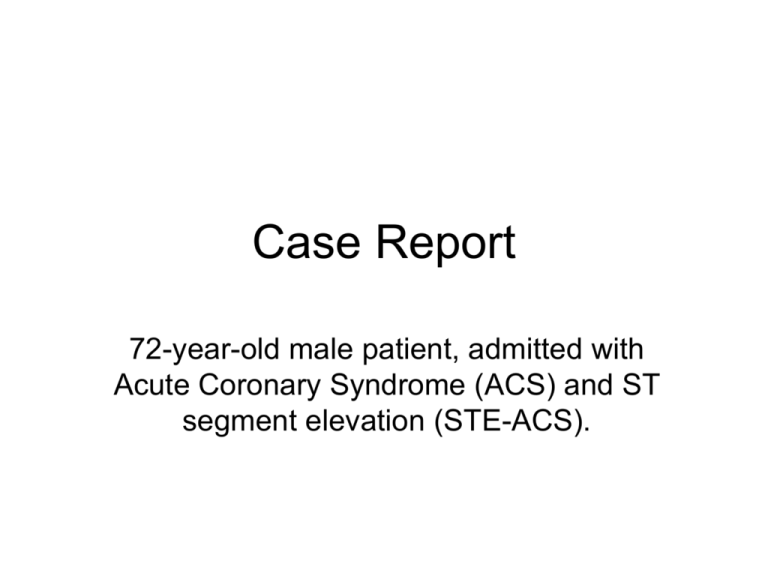
Case Report 72-year-old male patient, admitted with Acute Coronary Syndrome (ACS) and ST segment elevation (STE-ACS). ECG CHRONOLOGIC EVOLUTION • 72-year-old male patient, admitted with clinical picture of ACS and ST elevation (STE-ACS). – ECG1 - admittance – ECG2 - 6 hours later – ECG3 - after primary angioplasty. • The presence of elevated ST in I and VL could suggest occlusion of: left anterior descending coronary artery proximal to the first diagonal, first obtuse marginal branch of the left circumflex (LCX) or first diagonal artery. • In this case, which is the culprit artery? At the end we will present the result of the coronary angiography. ECG1 - Admittance Extreme left axis deviation: Left Anterior Fascicular Block (LAFB): SÂQRS - 400, SIII>SII, qR in I and VL Minimal ST segment elevation in I and VL; Poor progression of r wave on precordial leads; rV3 > rV4; Transition zone on precordial leads dislocate to the left (V5). r waves with low voltage on left leads (V5-V6). COMMENTARIES ST segment elevation in I indicates that LCX is the affected artery because the injury vector is directed not only downwards, but also to the left#. r waves with low voltage on left leads (V5-V6) is observed in lateral B1 MI (most probable place of occlusion LCX). Q wave in I and VL could be manifestation of Mid-anterior MI A4, but in this case we think that initial q waves in I and VL are secondaries to LAFB( CCW rotation of QRS loop on frontal plane) # Observation: Only in the cases of extreme dominant RCA or LCX have found that this rule may fail1. Conclusion: B1 MI or lateral MI. 1) Bayés de Luna A, Basic Electrocardiography. Normal and Abnormal ECG Patterns. Chapter 11. ECG2 - 6 hours later LAFB Pathologic initial Q wave from V4 to V6. ST segment elevation from V4 to V6 and minimal in I and VL. ECG3 - after successful primary angioplasty T wave inversion from V4 to V6: Subepicardial ischemia in lateral wall. In this case the rule failed! Coronariography report: It is observed: suboclusion of the left anterior descending coronary artery proximal to the first septal branch and total occlusion of the first diagonal artery branch (culprit artery?). Both had been treated by the " kissing balloon" technique. The right coronary artery and left cirunflex were normal. References1;2 are interesting citations for the differential diagnosis in cases of acute MI entaliling ST-segment elevation in lead VL. 1) 2) Birnbaum Y, Hasdai D, Sclarovsky S, Herz I, Strasberg B, Rechavia E. Acute myocardial infarction entailing STsegment elevation in lead aVL: electrocardiographic differentiation among occlusion of the left anterior descending, first diagonal, and first obtuse marginal coronary arteries. Am Heart J. 1996 Jan;131:38-42. Iwasaki K, Kusachi S,Kita T, Taniguchi G. Prediction of isolated first diagonal branch occlusion by 12-lead electrocardiography: ST segment shift in leads I and aVL. J Am Coll Cardiol. 1994 Jun; 23:1557-1561. Birnbaum Y, Hasdai D, Sclarovsky S, Herz I, Strasberg B, Rechavia E. Acute myocardial infarction entailing ST-segment elevation in lead aVL: electrocardiographic differentiation among occlusion of the left anterior descending, first diagonal, and first obtuse marginal coronary arteries. Am Heart J. 1996 Jan;131:38-42. • • • • • • Acute myocardial infarction with ST elevation in lead aVL may represent involvement of the first diagonal or the first obtuse marginal branch. This study assesses the correlation among different electrocardiographic patterns of acute myocardial infarction with ST elevation in aVL and the site of the infarct-related artery occlusion. Patients who underwent coronary angiography within 14 days of infarction with an unequivocal culprit lesion were included. Fifty-seven patients were evaluated. The culprit lesion was in the left anterior descending coronary artery proximal to the first diagonal, first diagonal, and first obtuse marginal branches, in 38, 8, and 11 patients, respectively. ST elevation in aVL and V2 through V5 signifies left anterior descending artery occlusion proximal to the first diagonal branch: positive predictive value(PPV) and negative predictive value(NPV) of 95% and 94%, respectively. ST elevation in aVL and V2, not accompanied by ST elevation in V3 through V5, favors occlusion of the first diagonal branch (PPV, 89%; NPV, 100%). ST elevation in aVL accompanied by ST depression in V2 predicts obstruction of the first obtuse marginal branch (PPV, 100%; NPV, 98%). Iwasaki K, Kusachi S,Kita T, Taniguchi G. Prediction of isolated first diagonal branch occlusion by 12-lead electrocardiography: ST segment shift in leads I and aVL. J Am Coll Cardiol. 1994 Jun; 23:1557-1561. OBJECTIVES. This study was performed to determine electrocardiographic (ECG) features that could distinguish first diagonal branch occlusion from left anterior descending coronary artery occlusion. BACKGROUND. The ECG findings associated with first diagonal branch obstruction have not previously been compared with those of left anterior descending coronary artery obstruction. METHODS. The ECG findings in 34 patients with isolated diagonal branch occlusion (group 9) were compared with those in 20 patients with occlusion at site 6 (group 6) and 20 with occlusion at site 7 (group 7), according to American Heart Association classification. This study had a power > 80% to detect a 50% difference between groups at a probability value of 0.05. RESULTS. ST segment elevation was observed in leads I and aVL for all group 9 patients, in 80% (p < 0.05) of group 6 patients for lead I and 90% for lead aVL and in 50% (p < 0.01) of group 7 patients for lead I and 55% (p < 0.01) for lead aVL. Similarly, there was a higher incidence of abnormal Q waves and inverted T waves in leads I and aVL in group 9 than in groups 6 and 7. In contrast, group 9 showed a significantly lower incidence of ST segment elevation (3.4%), abnormal Q waves (3.0%) and inverted T waves (0%) in lead V1 than group 6 (80%, 40% and 90%, respectively) and group 7 (75%, 60% and 70%, respectively) (p < 0.01 for each). Multivariate analysis revealed that abnormalities in leads I and aVL, combined with a normal lead V1 (and V6), provided good criteria for distinguishing isolated diagonal branch occlusion from left anterior descending coronary artery occlusion. CONCLUSIONS. Isolated diagonal branch occlusion more frequently caused ECG abnormalities in leads I and aVL and less frequently caused changes in the precordial leads compared with left anterior descending coronary artery obstruction, indicating that leads I and aVL represent myocardium perfused by the diagonal branch. Opinion Dr Ricardo Pizarro from Panama ripibro@hotmail.com • Greetings for everyone, and thank you very much to Drs. Raimundo Barbosa and Prof. Andres R. Perez R. for these ECGs that made me review the topic; I think this is an acute MI, middle-anterior and middle-lateral in evolution, that was solved by primary angioplasty (see ECG 3). I see ST elevation in DI, aVL, V3-V6, and ST depression in DII, DIII and aVF (DIII greater than DII, I think), all of which may be caused by occlusion of the first diagonal artery (see Chapter 11 of the book "Basic Electrocardiography" by Dr. Antoni Bayes de Luna). • Well, now we only need the opinions by the expert Colleagues and the result of the coronary angiography. • PS: I hope you have a lot of fun in these Carnival; here in Panama it is a very serious business.
